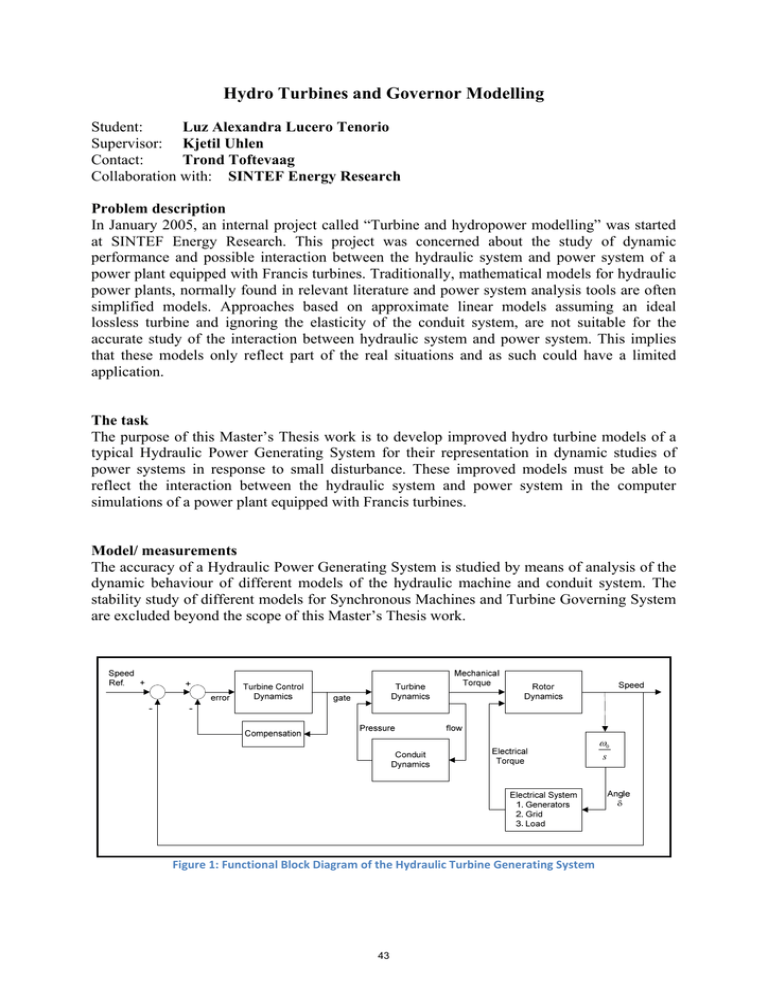Hydro Turbines and Governor Modelling
advertisement

Hydro Turbines and Governor Modelling Student: Luz Alexandra Lucero Tenorio Supervisor: Kjetil Uhlen Contact: Trond Toftevaag Collaboration with: SINTEF Energy Research Problem description In January 2005, an internal project called “Turbine and hydropower modelling” was started at SINTEF Energy Research. This project was concerned about the study of dynamic performance and possible interaction between the hydraulic system and power system of a power plant equipped with Francis turbines. Traditionally, mathematical models for hydraulic power plants, normally found in relevant literature and power system analysis tools are often simplified models. Approaches based on approximate linear models assuming an ideal lossless turbine and ignoring the elasticity of the conduit system, are not suitable for the accurate study of the interaction between hydraulic system and power system. This implies that these models only reflect part of the real situations and as such could have a limited application. The task The purpose of this Master’s Thesis work is to develop improved hydro turbine models of a typical Hydraulic Power Generating System for their representation in dynamic studies of power systems in response to small disturbance. These improved models must be able to reflect the interaction between the hydraulic system and power system in the computer simulations of a power plant equipped with Francis turbines. Model/ measurements The accuracy of a Hydraulic Power Generating System is studied by means of analysis of the dynamic behaviour of different models of the hydraulic machine and conduit system. The stability study of different models for Synchronous Machines and Turbine Governing System are excluded beyond the scope of this Master’s Thesis work. 0 s Figure 1: Functional Block Diagram of the Hydraulic Turbine Generating System 43 Appropriate models of the hydraulic turbine and conduit system are developed in various degrees of detail. Firstly, nonlinear models for a simple turbine without surge tank considering the inelastic and elastic travelling wave effects have been developed. After that, nonlinear models considering the inelastic and elastic travelling wave effects for a turbine with surge tank for Hydropower Systems with long length penstocks are implemented. Finally, the nonlinear models for a turbine with long length penstocks are linearized at an operating point considering both the nonlinear turbine characteristics and the travelling wave effects. The stability analysis of these implemented models contains power-flow calculation, linear analysis and time-domain simulation in the simulation software SIMPOW® and the dynamic simulation tool LVTrans. Calculation Once the Hydro Power Plant models are established, the block diagram of the different models representing the dynamic behaviour is implemented, simulated and studied in the power simulation software SIMPOW. The objective of the dynamic modelling of the test system is to analyze the stability characteristics of the Hydro Power System about the steadystate operating condition following a three-phase fault to ground at t=1 s. This disturbance is simulated for a period of 5.0 ms. The models of the Hydraulic Turbine for the stability analysis in a Hydro Power System has been implemented in SIMPOW with the synchronous generator modelled by a detailed model with damping, the turbine governing system modelled by a general speed-governing model, and the hydraulic turbine is represented by various models of varying degrees of detail. The models of the hydraulic turbine implemented in SIMPOW are listed below. Model 1 Model 2 Model 3 Model 4 Model 5 Model 6 Model 7 Simplified Nonlinear Turbine Model assuming Inelastic Water Column Nonlinear Turbine Model without Surge Tank assuming Inelastic Water Column Nonlinear Turbine Model without Surge Tank including Elastic Water Column Effect Nonlinear Turbine Model with Surge Tank assuming Inelastic Water Columns Nonlinear Turbine Model with Surge Tank assuming Elastic Water Column in Penstock and Inelastic Water Column in Upstream Tunnel Linear Turbine Model with Surge Tank assuming Inelastic Water Columns in Penstock and Upstream Tunnel Linear Turbine Model with Surge Tank including Elastic Water Column in Penstock Conclusion This Master’s Thesis work deals with the development of improved hydro turbine models for the evaluation of system performance in response to small signal disturbances. Approaches based on approximate linear models assuming an ideal lossless turbine and ignoring the elasticity of the conduit system, are not suitable for the accurate study of the interaction of hydraulic system and power system. In addition, the parameters of these models are often estimated roughly. This implies that these models only reflect part of the real situations and as such could have a limited application. 44



